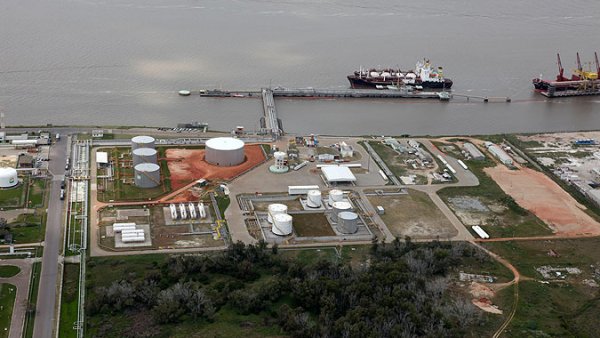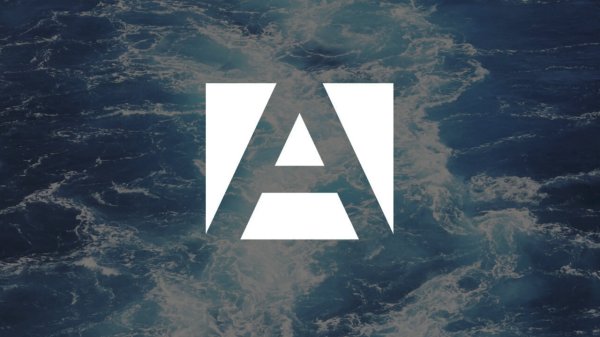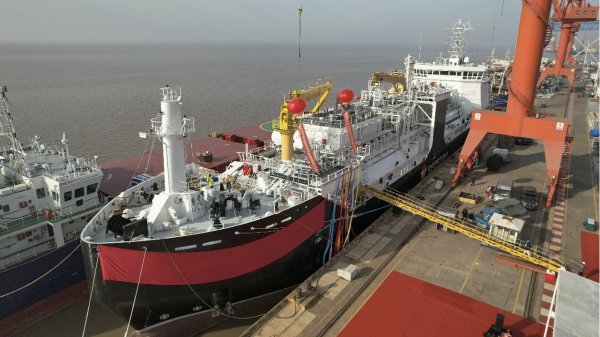Engine for world's first ethane-fuelled LEG carrier passes test
G50 engine will also be able to run on heavy fuel oil (HFO), marine diesel oil (MDO) and marine gas oil (MGO).
MAN Diesel & Turbo has confirmed that its G50 engine has successfully passed a Type Approval Test (TAT) at Mitsui in Japan. Upon entering service, the engine will power the world's first ethane-fuelled eco-friendly liquefied ethane gas (LEG) carrier - the first of three such vessels to be built in China by SinoPacific Shipyard for the German shipowner, Hartmann Reederei.
Besides operating on ethane, the flexible ME-GI engine will also be able to run on heavy fuel oil (HFO), marine diesel oil (MDO) and marine gas oil (MGO). Propulsion efficiency will be further improved by employing an MAN Kappel propeller with rudder-bulb system.
The G50-type has been developed with an eye on reducing production costs and accordingly features a lower weight and shorter length than its predecessor, while still being able to boast the same power output, according to MAN.
The DNV-GL classification society oversaw proceedings in Japan where the engine was tested as an ME-C type running on MGO but its gas system is also said to have successfully completed a pressure and function test.
The first test and operation on ethane gas is scheduled to take place after loading in Texas aboard the 36,000-cubic-metre LEG carrier once ethane gas has been bunkered, after which the engine will officially be named a 7G50ME-GIE (Gas Injection Ethane) type.
The news of the successful TAT follows the announcement by a JACCAR/Hartmann Reederei joint venture for an order of another 5 × 85,000 m3 'Eco Star 85K' very large ethane carriers (VLECs) with each vessel to be powered by a single MAN B&W 6G60ME-GIE main engine. In addition, these latest 5 vessels will be IMO Tier III NOx-compliant through the use of MAN Diesel & Turbo's proprietary exhaust gas recirculation (EGR) system.
This latest order brings the total of ethane-burning ME-GIE engines on order with MAN Diesel & Turbo to eight - with more in the pipeline, the company says.
The ME-GI engine
The ME-GI engine gives shipowners and operators the option of using either HFO or gas - predominantly natural gas.
MAN Diesel & Turbo has also developed an ME-LGI version of the new technology that is capable of operating on methanol, and is currently developing an ME-LGI version that is able to run on LPG, the latter being deliverable from the second quarter of 2018.
"MAN Diesel & Turbo sees significant opportunities arising for gas-fuelled tonnage as concerns about both CO2 and SOx emission increase. Indeed, research indicates that the ME-GI engine delivers significant reductions in CO2, NOx and SOx emissions. Furthermore, the ME-GI engine - in contrast to competing engines - has only a negligible, unburnt gas slip, consequently adding very little to the greenhouse effects of such slips. In addition, the diesel combustion principle leaves no formaldehyde emissions. All together, this makes the ME-GI engine series the most environmentally friendly technology available for marine propulsion," MAN said.
The vessel
Hartmann developed the so-called 'Ethylene Carrier Eco Star 36K' in cooperation with engineering consultants HB Hunte Engineering and has already concluded a long-term agreement for the newbuilding and its sisters with Saudi Arabian petrochemical company, SABIC.
The new vessel type differs from conventional gas carriers with its superstructures located at the bow, giving "an optimised distribution of weight and a concomitant reduced demand for ballast water, leading to reduced fuel consumption and emissions," according to MAN.
The new 'Svelte' bow design is said to enable the vessel to improve seakeeping at higher transit speeds and also improve fuel efficiency.
Another feature is the carrier's 'Star Trilobe' tank that is said to provide an increase in cargo capacity of nearly 30 percent, thus reducing shipping costs through economies of scale. The new vessels offer a cargo capacity of 36,000 cubic metres each for liquefied gas cargoes down to -104°C.
Currently, these vessels are the largest LEG carriers worldwide, and are due to be surpassed by the larger vessels in the new 5-vessel series previously mentioned.
Besides operating on ethane, the flexible ME-GI engine will also be able to run on heavy fuel oil (HFO), marine diesel oil (MDO) and marine gas oil (MGO). Propulsion efficiency will be further improved by employing an MAN Kappel propeller with rudder-bulb system.
The G50-type has been developed with an eye on reducing production costs and accordingly features a lower weight and shorter length than its predecessor, while still being able to boast the same power output, according to MAN.
The DNV-GL classification society oversaw proceedings in Japan where the engine was tested as an ME-C type running on MGO but its gas system is also said to have successfully completed a pressure and function test.
The first test and operation on ethane gas is scheduled to take place after loading in Texas aboard the 36,000-cubic-metre LEG carrier once ethane gas has been bunkered, after which the engine will officially be named a 7G50ME-GIE (Gas Injection Ethane) type.
The news of the successful TAT follows the announcement by a JACCAR/Hartmann Reederei joint venture for an order of another 5 × 85,000 m3 'Eco Star 85K' very large ethane carriers (VLECs) with each vessel to be powered by a single MAN B&W 6G60ME-GIE main engine. In addition, these latest 5 vessels will be IMO Tier III NOx-compliant through the use of MAN Diesel & Turbo's proprietary exhaust gas recirculation (EGR) system.
This latest order brings the total of ethane-burning ME-GIE engines on order with MAN Diesel & Turbo to eight - with more in the pipeline, the company says.
The ME-GI engine
The ME-GI engine gives shipowners and operators the option of using either HFO or gas - predominantly natural gas.
MAN Diesel & Turbo has also developed an ME-LGI version of the new technology that is capable of operating on methanol, and is currently developing an ME-LGI version that is able to run on LPG, the latter being deliverable from the second quarter of 2018.
"MAN Diesel & Turbo sees significant opportunities arising for gas-fuelled tonnage as concerns about both CO2 and SOx emission increase. Indeed, research indicates that the ME-GI engine delivers significant reductions in CO2, NOx and SOx emissions. Furthermore, the ME-GI engine - in contrast to competing engines - has only a negligible, unburnt gas slip, consequently adding very little to the greenhouse effects of such slips. In addition, the diesel combustion principle leaves no formaldehyde emissions. All together, this makes the ME-GI engine series the most environmentally friendly technology available for marine propulsion," MAN said.
The vessel
Hartmann developed the so-called 'Ethylene Carrier Eco Star 36K' in cooperation with engineering consultants HB Hunte Engineering and has already concluded a long-term agreement for the newbuilding and its sisters with Saudi Arabian petrochemical company, SABIC.
The new vessel type differs from conventional gas carriers with its superstructures located at the bow, giving "an optimised distribution of weight and a concomitant reduced demand for ballast water, leading to reduced fuel consumption and emissions," according to MAN.
The new 'Svelte' bow design is said to enable the vessel to improve seakeeping at higher transit speeds and also improve fuel efficiency.
Another feature is the carrier's 'Star Trilobe' tank that is said to provide an increase in cargo capacity of nearly 30 percent, thus reducing shipping costs through economies of scale. The new vessels offer a cargo capacity of 36,000 cubic metres each for liquefied gas cargoes down to -104°C.
Currently, these vessels are the largest LEG carriers worldwide, and are due to be surpassed by the larger vessels in the new 5-vessel series previously mentioned.

|
IMO approves pricing mechanism based on GHG intensity thresholds
Charges to be levied on ships that do not meet yearly GHG fuel intensity reduction targets. |
|
|
|
||

|
VARO Energy expands renewable portfolio with Preem acquisition
All-cash transaction expected to complete in the latter half of 2025. |
|
|
|
||

|
NYK trials biofuel in milestone coal carrier test
Vessel is used to test biofuel for domestic utility company. |
|
|
|
||

|
H-Line Shipping orders LNG bunkering vessel
Vessel with 18,000-cbm capacity to run on both LNG and MDO. |
|
|
|
||

|
How to engineer and manage green shipping fuels | Stanley George, VPS
Effective management strategies and insights for evolving fuel use. |
|
|
|
||

|
Swedish government bans scrubber wastewater discharges
Discharges from open-loop scrubbers to be prohibited in Swedish waters from July 2025. |
|
|
|
||

|
MAN Energy Solutions achieves 100% load milestone for ammonia engine
Latest tests validate fuel injection system throughout the entire load curve. |
|
|
|
||

|
Petrobras secures ISCC EU RED certification for B24 biofuel blend at Rio Grande
Blend consisting of 24% FAME is said to have been rigorously tested to meet international standards. |
|
|
|
||

|
Stolt-Nielsen to fully control Avenir LNG with acquisition
Share purchase agreement to buy all shares from Golar LNG and Aequitas. |
|
|
|
||

|
Bureau Veritas supports launch of CIMC SOE's LNG bunkering vessel
Handover of Seaspan Energy's cutting-edge 7,600-cbm vessel completed. |
|
|
|
||
Related Links
- · Order for biggest ever gas-fuelled ethane carriers [Insights]
- · Evergas orders dual-fuel gas carriers [Insights]
- · New notation for low-flashpoint fuels [Insights]
- · Bureau Veritas publishes LNG bunkering notation [Insights]
- · 50DF engine 'successfully' tested to run on ethane fuel [Insights]
- · Japan [Directory]

